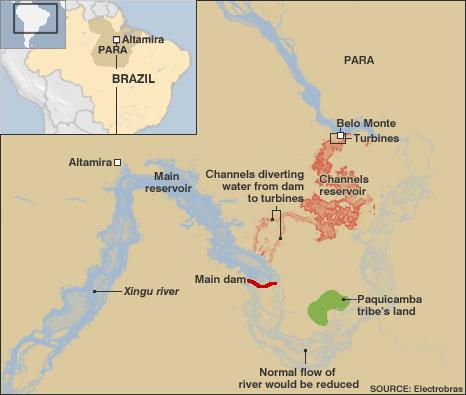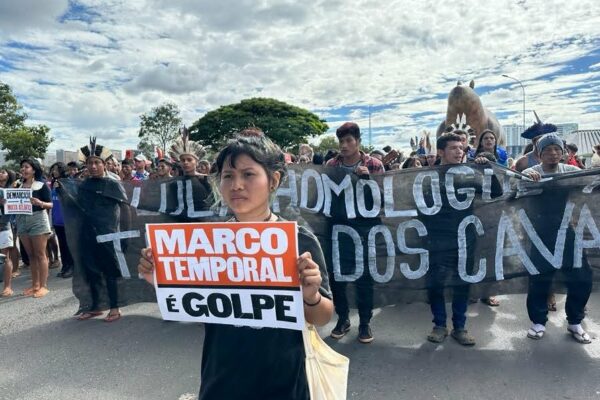The Federal Injunctions of the Belo Monte Auction
The Belo Monte auction took place on April 20, 2010 amidst the street protests taking place in major cities across Brazil. Leading up to the auction date three injunctions (restraining orders) were issued by a federal judge of Altamira. Favoring the civil action lawsuits filed by the Brazilian Federal Public Prosecutors Office and human rights and environmentalist NGOs, the injunctions were struck down by a regional appellate court judge, under heavy political pressure from the Lula government. It is important to stress that the auction took place while the third restraining order was in full effect (as explained below).
The first injunction suspended the projects first phase of the environmental license and the auction on the grounds that proper regulations were not followed according to Article 176 of the Brazilian constitution, which regulates mining and hydroelectric activity on indigenous peoples’ lands.
The second injunction temporarily canceled the environmental license granted by the environmental agency IBAMA (The Brazilian Institute of Environment and Renewable Natural Resources) and the auction on the grounds that the extent of social and environmental impacts and the viability of the project were still unknown. Furthermore, proper consultations with the communities that would be affected by the dam were not undertaken, ignoring Brazilian law supported by ILO Convention 169 stipulating the need for free, prior, informed consent of the affected indigenous peoples.
The third injuction claimed that the auction was held with different data for the reservoir size than the data approved by the provisional license. The projected area of Belo Monte’s reservoir size in the project auction would be 29,47% greater than that for which the provisional license had been granted. On those grounds, the third injunction asked for the auction to be cancelled. The injunction also asked for a new comprehensive environmental impact assessment.
Each injunction was overturned in a matter of hours by the President of the Appellate Court for ‘Region 1’ – which covers the entire Amazon basin – succumbing to political pressure from the Lula administration The third injunction was served on April 20th, minutes before the Belo Monte auction began, entering the public domain somewhere between 12.25 pm and 1pm, and the auction starting at 1.20 or 1.24 pm). The Attorney General’s office claims that the parties were notified before the auction started, yet ANEEL disregarded the message and held the project auction anyways.
The Attorney General’s office has since claimed it will investigate whether the injunction was received before the auction began. If this was the case, and the injunction was ignored as has been claimed, there is the possibility that the auction may be considered illegal and its outcome therefore cancelled.
Winners of the Auction
The auction lasted seven minutes on April 20th, 2010 and was won by the consortium Norte Energia who bid 6% below the auction price of $47USD per megawatt-hour. This outcome went against the expectations of the Brazilian government and public opinion, since the opposing consortium Belo Monte Energia was composed of big players in the hydroelectric business such as Odebrecht, Camargo Corrêa, Andrade Gutierrez, and Vale. Odebrecht and Camargo Corrêa had dropped out of the auction previously, arguing that the auction price was too low to make a decent return.
Norte Energia is composed of:
Chesf (Eletrobras)- 49.98%
Queiroz Galvão- 10.02%
Galvão Engenharia- 3.75%
Mendes Júnior- 3.75%
Serveng- 3.75%
JMalucelli Construtora- 9.98%
Contern Construções (Grupo Bertin)- 3.755%
Cetenco Engenharia- 5%
Gaia Energia e Participações (Grupo Bertin)- 10.02%
Since April 20th, Odebrecht, Camargo Corrêa, Andrade Gutierrez, and Vale have sought to join the winning consortium and play a part in building and administrating Belo Monte. It has also been reported that two companies- Queiroz Galvão and J. Malucelli – have considered dropping out of the consortium. Since then, J. Malucelli confirmed they would stay in the consortium and it is very likely that Queiroz Galvão will remain in the consortium as well. It has been reported that Vale, Alcoa, Votorantim, CSN, Gerdau, and Braskem continue to be interested in participating as partners to Norte Energia in Belo Monte.
Financing: Public Money, Subsidies, and Belo Monte’s True Costs
The true costs of Belo Monte considerably exceed the official R$ 19 billion budget. Current estimates for the engineering and construction costs vary between R$ 24 and R$ 30 billion ($13 – $17.5 billion USD). Indirect costs due to the influx of migrant workers and relocation of local dwellers are estimated up to R$ 8 billion.
Moreover, the loss of biodiversity, climate change impacts through deforestation, and the loss of cultures and qualities of life have yet to be quantified are still treated as ‘externalities’ not included in official calculations.
In addition, the financing of the project is heavily subsidized by the Brazilian National Development Bank BNDES and ultimately by Brazilian taxpayers through the federal government’s use of funds from the Workers’ Assistance Fund (FAT) and public pension funds. To keep Belo Monte afloat, BNDES is offering 30-year loans at the unprecedented interest rate of 4%, far below the cost of capital, while also serving businesses tax exemptions the value of which is estimated to be roughly R$ 6 billion. BNDES has promised to extend its largest loans ever to Belo Monte – equaling 80% of the project’s cost while coordinating the remaining 20% of private financing – without which the project could not exist.
Indigenous Response
Indigenous groups from both the Upper and Lower Xingu basin, including the Kayapo, Arara, Juruna, and Xipaia tribes, have voiced their vociferous opposition to the government’s plans to dam the Xingu. Indigenous leaders have repeatedly promised to lay down their lives to defend the river upon which they depend for survival.
Shortly after the Belo Monte auction Kayapo Indians led by Chief Megaron Txukarramãe blockaded a major highway, the BR-80, in Mato Grosso State in protest at the government’s determination to push through the massive Belo Monte Dam. The blockade remains in place as of this writing, disrupting a major transport artery for commercial goods. In a statement Megaron calls President Lula the “enemy number one” of Brazil’s indigenous peoples, vowing to maintain the blockade until Belo Monte is canceled or “die fighting for our rights”.
Chief Megaron has been joined in his protests by Kayapo Chief Raoni Metuktire, an emblematic leader of indigenous resistance to the Brazilian government’s plans to dam the Xingu River for over 20 years. In a May 1st interview with the French channel TF1, Chief Raoni said “I have asked my warriors to prepare for war and I have spoken of this with other tribes from the upper Xingu. We will not let them [build this dam].”
In Altamira, the region’s leaders are planning a major encounter of indigenous peoples of the Upper and Lower Xingu in order to solidify plans to mount a united resistance to Belo Monte. An outcome of this meeting could be the establishment of a multi-ethnic indigenous village at Pimental Island, the proposed construction site. This bold step would send a message to the Brazilian government and the private companies seeking to build the dam that the region’s indigenous people will stand firmly in their way.
Belo Monte Dam Design
Belo Monte includes three dam walls and two reservoirs. The main dam is located on Pimental Island and will create a ‘main reservoir’ behind it that will flood an area larger than the city of Chicago, mostly in the municipality of Altamira. From this reservoir, two water-diversion canals would be excavated to channel water to a second reservoir behind the main turbine house. This secondary reservoir will be reinforced by a secondary dam. Finally the main turbine house acts as a third dam wall, at which the water will be forced through turbines to generate electricity.
The design is entirely inefficient. The stream flow of the Xingú River varies wildly between the rainy season and the dry season. In the dry season, only 10% of the dam’s 11,233 MW installed capacity would be generated. In order to fulfill the project’s full installed capacity, additional reservoirs would need to be built upstream to assure more constant energy provision.

Belo Monte Impacts
Upon diverting the Xingu River to a channeled reservoir, the 100km stretch known as the ‘Volta Grande’ (Big Bend) will by dried out, drastically reducing flora and fauna populations, especially fish, upon which the Juruna people of the Paquiçamba indigenous territory depend for survival.
The fish fauna of the Xingu river is extremely rich with an estimated 600 fish species and with a high degree of endemism and many species found nowhere else in the world1. The area that will either be dried out or drowned because of the dam includes the entire known world distribution of a number of species such as the Zebra Pleco (Hypancistrus zebra) and the Sunshine Pleco (Scobinancistrus aureatus), two kinds of catfish, the Slender Dwarf Pike Cichlid (Teleocichla centisquama), the plant-eating piranha (Ossubtus xinguense) and the Xingu Dart-Poison frog (Allobates crombiei). The EIA has failed to mention how the dam will impact these unique species.
This dry stretch will also prevent the Xikrin people of the Trincheira-Bacajá indigenous territory from accessing the Xingu River. The Bacajá River on which they live is one of the main affluents of the Xingu, and the Xikrin depend on access to the Xingú River for trade and transportation to maintain their livelihoods.
Meanwhile, renowned scientist Philip Fearnside argues that if even one additional reservoir is built upstream to regulate the seasonal changes in stream flow, CO2 emissions equivalent to over 2 million cars would be emitted by Belo Monte and this additional reservoir.
Alternatives to Belo Monte’s Construction
WWF Brazil released a report in 2007 stating that Brazil could cut its expected demand for electricity by 40% by 2020 by investing in energy efficiency. The power saved would be equivalent to 14 Belo Monte hydroelectric dams and would result in national electricity savings of up to R$33 billion (US$19 billion)2.
Ex-director of ANEEL Afonso Henriques Moreira Santos stated that large dams such as Belo Monte were not necessary to meet the government’s goal of 6% growth per year. Rather, he argued that Brazil could grow through increasing its installed capacity in wind power, currently only at 400 MW3.
–––
1 Camargo, M., T. Giarrizzo, V. Isaac. 2004. Review of the Geographic Distribution of Fish Fauna of the Xingu River Basin, Brazil. Ecotropica 10: 123-147
2 WWF-Brazil’s Sustainable Power Sector Vision 2020 – English Summary
3 ‘Governo criará “monstro”, diz ex-diretor da Aneel’ Angel, C. (2010)













